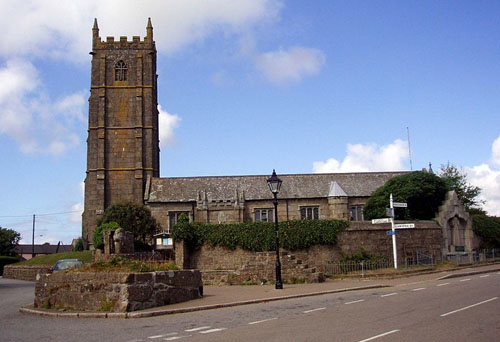
The church of St Buryan
 A church has stood on the current site since ca. 930 AD, built by King Athelstan in thanks for his successful conquest of Cornwall on the site of the oratory of Saint Buriana (probably founded in the 5th century). The Charter from Athelstan endowed the building of collegiate buildings and the establishment of one of the earliest monasteries in Cornwall and was subsequently enlarged and rededicated to the saint in 1238 by Bishop William Briwere.
A church has stood on the current site since ca. 930 AD, built by King Athelstan in thanks for his successful conquest of Cornwall on the site of the oratory of Saint Buriana (probably founded in the 5th century). The Charter from Athelstan endowed the building of collegiate buildings and the establishment of one of the earliest monasteries in Cornwall and was subsequently enlarged and rededicated to the saint in 1238 by Bishop William Briwere.
The collegiate establishment consisted of a dean and three prebendaries. Owing to the nature of the original Charter from King Athelstan, the parish of St Buryan was long regarded as a Royal Peculiar thus falling directly under the jurisdiction of the British monarch as a separate diocese, rather than the Church. This led to several hundred years of arguments between The Crown and the Bishop of Exeter over control of the parish, which came to a head in 1327 when blood was shed in the churchyard, and in 1328 St Buryan was excommunicated by the Bishop. St Buryan was not reinstated until 1336.
Only two of the King's appointed Deans appear to have actually lived in the diocese of St Buryan for more than a few months, and the combination of these factors led to the subsequent ruinous state of the church in 1473. The church was subsequently rebuilt and enlarged, the tower was added in 1501 and further expansion took place in the late 15th and 16th centuries when the bulk of the present church building were added. Further restoration of the interior took place in 1814, and the present Lady Chapel was erected in 1956.
The church is currently classified as a Grade I listed building. The Deanery was annexed in 1663 to the Bishopric of Exeter after the English Civil War, however, it was again severed during the episcopacy of Bishop Harris , who thus became the first truly independent dean. The current diocese holds jurisdiction over the parishes of St Buryan, St Levan, and Sennen. St Buryan church is famous for having the heaviest peal of six bells in the world, and a recent campaign to restore the church's bells, which had fallen into disuse, has enabled all six to be rung properly for the first time in decades. The church has four 15th century misericords, two either side of the chancel, each of which shows a plain shield.
Article supplied by Keith Waters, Senior Warden, Coronation Stone Court No.50 who has just moved to St. Buryan

The Masonic Order of Athelstan
in England, Wales and its Provinces Overseas ~ Province of Sussex
Click here to enter
